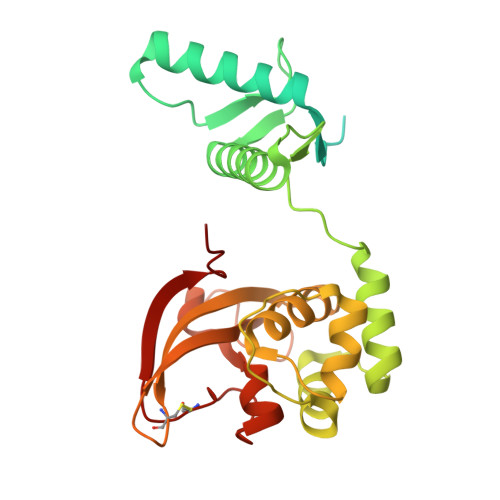Insights into the catalytic mechanism of archaeal peptidoglycan endoisopeptidases from methanogenic phages.
Guo, L., Zhu, Y., Zhao, N., Leng, H., Wang, S., Yang, Q., Zhao, P., Chen, Y., Cha, G., Bai, L., Bao, R.(2025) Int J Biol Macromol 296: 139672-139672
- PubMed: 39793783
- DOI: https://doi.org/10.1016/j.ijbiomac.2025.139672
- Primary Citation of Related Structures:
8JX4, 8Z4F - PubMed Abstract:
Archaeal peptidoglycan, a crucial component of the cell walls of Methanobacteria and Methanopyri, enhances the tightness of methanogenic cells and their resistance to known lytic enzymes and antibiotics. Although archaeal peptidoglycan endoisopeptidases (Pei) can reportedly degrade archaeal peptidoglycan, their biochemistry is still largely unknown. In this study, we investigated the activity and catalytic properties of the endoisopeptidases PeiW and PeiP using synthesized isopeptides identical to natural substrates. Enzymatic assays demonstrated their distinct substrate specificity and cleavage efficiency. The crystal structure of Pei revealed a catalytic mechanism resembling that of cysteine peptidases that use the 'CHD' triad to cleave isopeptide bonds. We also identified several key residues in the substrate binding site that confer recognition specificity, including Y174, V252 and C265. Based on the residues present in the active site and their influence on activity, we propose a classification of the archaeal peptidoglycan endoisopeptide family into four categories to facilitate the identification of new archaeal peptidases in the future. These insights into the structure and function of Pei suggest new strategies for use in methanogen biotechnology.
- Key Laboratory of Development and Application of Rural Renewable Energy, Biogas Institute of Ministry of Agriculture and Rural Affairs, Chengdu, Sichuan 610041, China.
Organizational Affiliation:
















